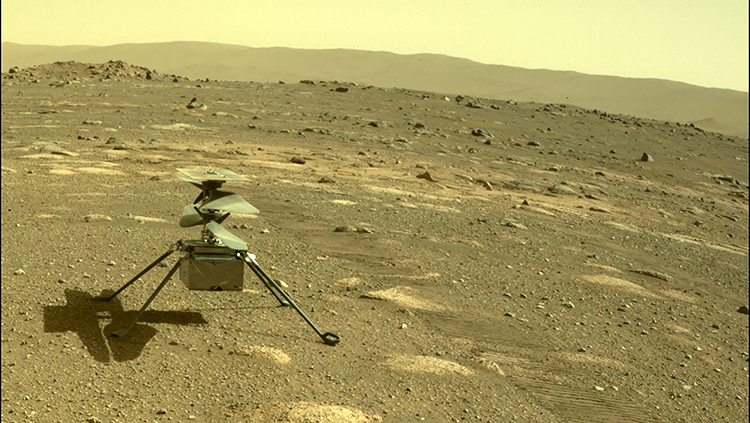
Have you ever operated a remote-control car, or maybe even a drone? Imagine making something fly on a planet 100 million miles away!
Scientists at NASA’s Jet Propulsion Laboratory (JPL) in Pasadena, California, not only imagined it—they made it happen. On April 19, 2021, NASA’s Ingenuity helicopter hovered above Mars for about 40 seconds, becoming the first powered aircraft to fly on another planet. Scientists did not control Ingenuity remotely, though. Mars is too far away for that. Instead, they programmed it to fly by itself.
To fly on its own, Ingenuity uses a tiny computer, like what is inside a smartphone. It also uses the technology of self-driving cars. Ingenuity communicates with Perseverance, the rover that delivered it to Mars. Scientists at JPL send commands to Perseverance, which sends them on to Ingenuity.
The distance from Earth wasn’t the only challenge engineers faced. Mars’s atmosphere is much thinner than the air around Earth, making liftoff more difficult. The helicopter had to be light enough to be lifted, and its blades had to spin extremely fast. Ingenuity is 19 inches tall and weighs 1.5 kilograms (4 pounds). It has two 4-foot blades that spin about 2,500 times per minute. The blades on a regular helicopter spin about 500 times per minute.
Mars also gets incredibly cold at night. Its temperatures can drop to -90°C (-130°F). Engineers put a small solar panel on the top of Ingenuity to charge its six batteries, which keep it running and warm.
Still another challenge the engineers faced related to gravity. On Mars, there is less gravity than there is on Earth. Engineers had to make sure that Ingenuity wouldn’t bounce and topple over when Perseverance unloaded it.
Ingenuity will pave the way for future exploration of Mars. Helicopters like Ingenuity will be able to provide detailed views of whole canyons as well as places where rovers can’t travel, like the walls of a crater.
What Do You Think? A high school student from Alabama came up with the name “Ingenuity.” Look up the meaning of the word. Do you think the name fits NASA’s helicopter? Why or why not? What might be some good names for future helicopters on Mars?
Reading Response Click on this link to respond to your reading. Print out the response page or upload it to your classroom site.
Photo Credit: Courtesy NASA/JPL-Caltech



